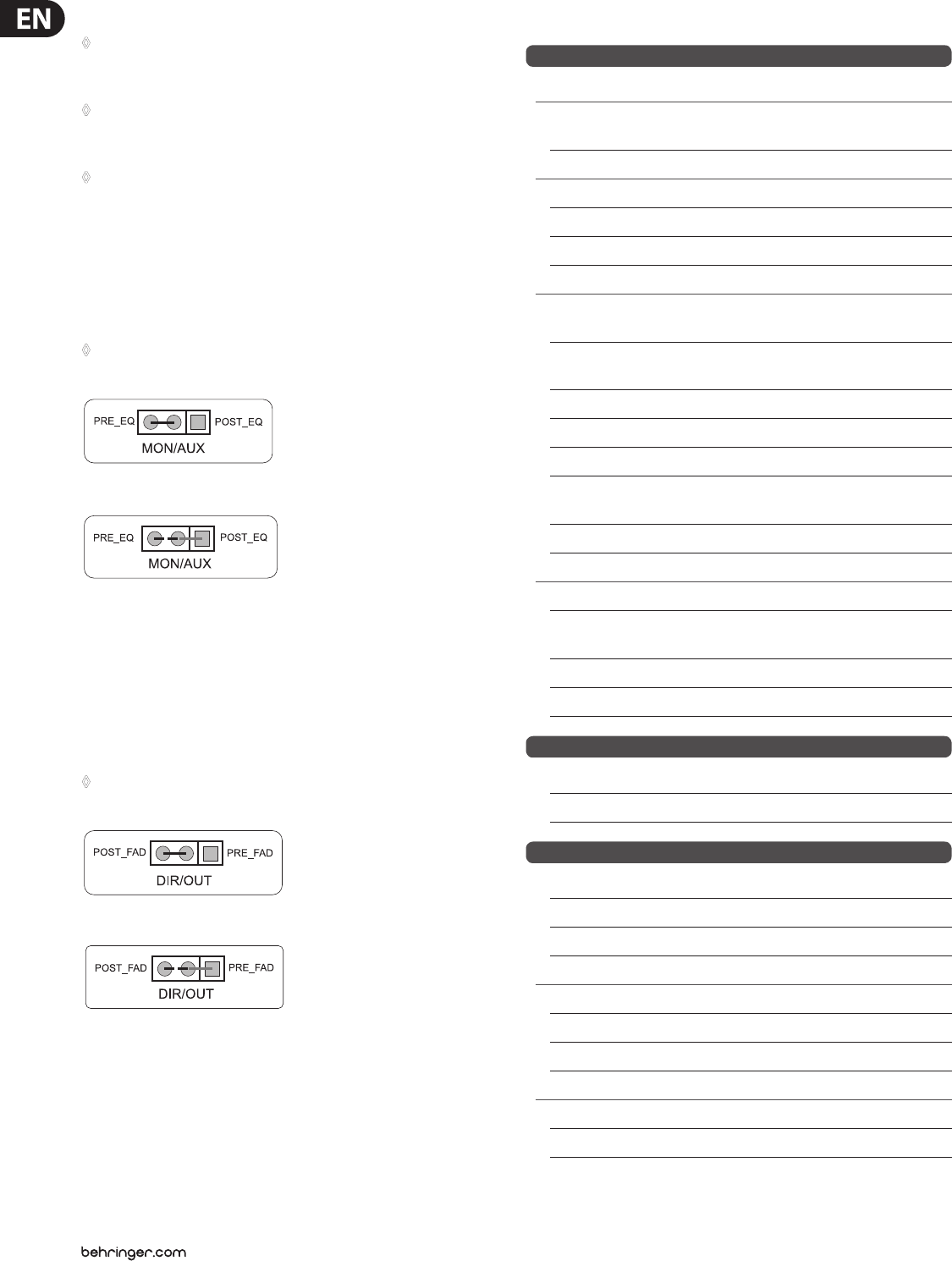
18 XENYX XL3200/XL2400/XL1600 User Manual
6. Modications
◊ These modifications require soldering. Attempt only if you are
experienced in using an iron on PCBs. Otherwise, refer to qualified
personnel. After modification the warranty becomes void.
◊ We wish to be absolutely clear that BEHRINGER cannot be held
responsible after you start disassembling your XENYX. If you make
much of your warranty privileges, think again.
◊ Links should not be threaded into the holes on the PCB, but are to
be soldered to the tinned areas around the holes. Bend the links a
little upwards.
6.1 Mon/Aux sends > post-EQ
Pre-fader switched monitor sends and aux sends are tapped o before the
equalizer. Do you prefer post-EQ? What are you waiting for? You don't have to
look far—the necessary information is found on the bottom side of the unit.
◊ Make sure to turn off the mixer and disconnect it from the mains before
removing the cover.
1) Strip the PRE EQ lead.
2) Solder a POST EQ link into place.
3) Make these modications to as many channels as required (does it have to be
all of them?).
6.2 Direct Out > pre-fader
If you prefer to use the Direct Out pre-fader than post-fader, the signal needs
to be tapped o before the fader and not after the fader. To perform this
modication, nd the label “DIR-OUT” on the circuit board.
◊ Make sure to turn off the mixer and disconnect it from the mains before
removing the cover.
1) Strip the POST FADER lead.
2) Solder a PRE FADER link into place.
3) Make these modications to as many channels as required.
7. Specications
Mono Inputs
Microphone Inputs (XENYX Mic preamp)
Type XLR connector, electronically balanced,
discrete input circuit RF rejection lters
Mic E.I.N.
1
(20 Hz - 20 kHz)
@ 0Ω source resistance -127dB / 129.7dB A-weighted
@ 50Ω source resistance -126dB / 128.3dB A-weighted
@ 150Ω source resistance -125dB / 126.5dB A-weighted
Frequency Response
To Direct Out <10Hz - 50kHz (-1dB)
<10Hz - 100kHz (-3dB)
To Insert Send <10Hz - 90kHz (-1dB)
<10Hz - 170kHz (-3dB)
Gain range 0dB to +60dB
Max. input level +24dBu @0dB Gain
Impedance approx. 2.6kΩ balanced
Signal-to-noise ratio 120dB / 122dB A-weighted
(0dBu In @ +22dB Gain)
Distortion (THD + N) typ. 0.0008%
Line Input
Type ¼" TRS jack, electronically balanced
Impedance approx. 20kΩ balanced,
approx. 10kΩ unbalanced
Gain range -10dB to +40dB
Max. input level +22dBu @ 0dB Gain
Channel Inserts
Type ¼" TRS jack, unbalanced
Max. input level +22dBu
Channel Direct Outs
Type ¼" TRS jack, balanced
Impedance approx. 75Ω balanced
Max. input level +22dBu
Crosstalk
2
Main fader closed 100dB
Channel muted 90dB
Channel fader muted 85dB
Frequency Response (Mic In → Main Out)
<20Hz - 20kHz +0dB / -1dB
<10Hz - 160kHz +0dB / -3dB


















